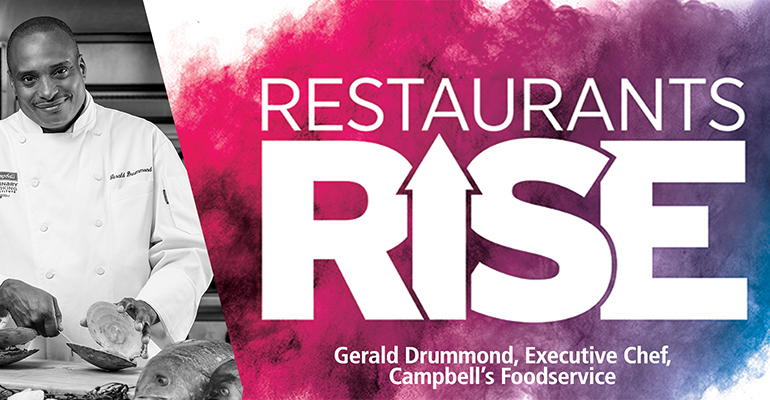Issues ranging from workplace equity to menu research and how restaurant leaders are addressing the challenge of the ongoing coronavirus pandemic were tackled in the two-week live Restaurants Rise digital series Aug. 11-20.
The digital community for the restaurant and foodservice industry,, hosted by Nation’s Restaurant News and Restaurant Hospitality, featured CEOs, executives and operators who addressed topics from ghost-kitchens and virtual brands for delivery-only, technology to drive sales and ways to innovate the curbside experience.
The webinars remain available on demand at the Restaurants Rise website.
Heres’s an overview of some topics covered.
Staff Member Bravery
Nate Weir, vice president of culinary at Denver-based Modern Restaurant Concepts, which includes fast-casual Modern Market Eatery and Lemonade, said worker efforts during the pandemic have astonished him.
“I am just amazed, frankly, by our teams and the effort that they’re putting forth,” Weir told a “Menu Equation” webinar. “I can’t imagine, honestly, going to work in the restaurant every single day. … Facing wave after wave of guests who — who knows where they’ve been? it’s a scary proposition. I’m amazed and encouraged by our team’s bravery and their willingness to give great experiences in the midst of that.”
Pandemic Accelerates Change
Barry McGowan, CEO of Plano, Texas-based full-service Fogo de Chão, said the pandemic has created “an exciting time” for our restaurant industry.
“I believe pre-COVID we were in this renaissance of making things better, more convenient [through use of] technology,” McGowan said. “I think CovIDhas just accelerated a lot of those things for all of us.”
The Changing Environment
Rob Gifford, president of the National Restaurant Association Educational Foundation, said the foundation looks forward to being part of a conversation that looks at how restaurants will change and adapt in a post-pandemic environment.

Rob Gifford, president of NRAEF, Sarah Lockyer, NRN and RH Publisher, Charlie Morrison, CEO of Wingstop.
Speaking on the “Leading with Purpose” panel, Gifford said: “On the other side of it is an industry that is going to be more resilient, more equitable, more exciting, more customer focused than it ever has been before,” he said. “Good can come out of this.”
Virtual Brands and Openness
Jamie Howe, trends and insights practice lead at Chicago-based Datassential, said consumers are OK with trying virtual brands but they don’t want to be deceived about their origins.
Howe, citing recent survey data in the “The Virtual Kitchen’s Time is Now” sessions, said customers “demand authenticity and communication.”
Wade Allen, senior vice president of innovation at Dallas-based Brinker International Inc., said the chain took authenticity into consideration when it developed its first delivery only brand: It’s Just Wings.
Launched in late June, It’s Just Wings is produced at 1,050 Chili’s Grill & Bar and Maggiano’s Little Italy locations and delivered by DoorDash. The restaurants are acting as “dark” kitchens for the new brand which is promoted as a “Brinker” concept.
“Consumers and guests are smart and they’ve been tricked and lied to in advertising before. And so it’s really important to be transparent,” Allen said.
Labor Challenges
Gerald Drummond, executive foodservice chef at Campbell’s Foodservice, said culinary professionals dealing with the pandemic and related economic downturn are being simultaneously tasked with controlling or reducing labor and other costs while luring consumers back into their restaurants.
Drummond, speaking on the “Overcoming the Labor Challenges of Today” program that was sponsored Campbell’s, suggested the creative use of core products across multiple dayparts and menu categories was one way to accomplish both goals.
For multi-unit operations, he noted that permitting more menu flexibility at the restaurant level could help chefs and kitchen managers better control inventory and play to their labor strength while changing things up enough to keep consumers interested.
 As an example of diversification that does not strain the prep team or inflate inventory, Drummond showed off an appetizer, side dish and entrée with greatly varying prices and descriptions – all of which featured the four core ingredients of chicken, baby arugula, jalapenos and a roasted poblano-white cheddar soup and sauce base.
As an example of diversification that does not strain the prep team or inflate inventory, Drummond showed off an appetizer, side dish and entrée with greatly varying prices and descriptions – all of which featured the four core ingredients of chicken, baby arugula, jalapenos and a roasted poblano-white cheddar soup and sauce base.
Off-Premise Strategy
Drummond of Campbell’s Foodservice also urged restaurant operators to use menu engineering to maximize sales and margins for items offered for take-out, grab-and-go and delivery. However, he advised them to hold back a portion of the menu — particularly some signature items and those that are hard to replicate at home — to entice dine-in business.
Drummond, speaking at an “On-Premise vs. Off-Premise Menu Strategies” session, said, “We know that when they [guests] come into your establishment, you are going to get those incremental dollars from beverages, side dishes, appetizers and desserts.”
During audience questions he shared additional tactics for luring in such guests that included regularly offering specials that showcase acclaimed local and seasonal products, ensuring that specials are offered across all menu categories and offering with take-out or delivered foods bounce-back discount offers for in-restaurant dining.
For off-premise offerings, Drummond said it is important for operators consider “containers, presentations and costs.” The chef added related to take-out and delivery packaging that it needs to “keep the integrity of your dish alive so that when the guest pops the lid off they are going to be pleased by what they see and remember” and that it be microwaveable, “as people want that ease of reheating.”
If possible, he added, the container should “be recyclable, as that is something people are looking at, as well.”
Growth in Virtual Concepts
Ric Gruber, owner and general counsel for Billy Bricks Wood Fired Pizza Inc., said he was able to leverage knowledge, facilities and people by adding virtual concepts to his Chicago-area brick-and-mortar operations.
Gruber, in an “Exploring Growth Now” panel sponsored by Grubhub, said he created the Petey Pastas, Mac Daddy’s and Capital Greens brands, which appear only in online ordering and delivery marketplaces.
Kevin Kearns, GrubHub senior vice president of restaurant network, said the panel wanted to help attendees understand how to capitalize on the demand for safe takeout; maximize digital marketing to grow online business; and leverage virtual concepts for additional revenue streams.
Gruber said Capital Greens, a salad and sandwich concept, was created to as a cold-catering business that would support larger delivery areas than pizza and help his organization more consistently use produce to avoid waste.

Kevin Kearns, senior vice president of restaurant network, Grubhub, Adam Wilson, director of restaurant success, Grubhub, Ric Gruber, owner & general counsel, Billy Bricks Wood Fired Pizza.
“My goal was to put up [virtual] things I already have equipment for, some systems in place for, and just expand upon them,” he said, noting that Mac Daddy’s enhanced macaroni-and-cheese offerings, such as the BBQ Chicken, uses the same topping ingredients and portions as the Billy Bricks’ signature pizzas, including the BBQ Chicken, so “making the build sheets was pretty easy” and “cross-training people was pretty easy.” And though Billy Bricks sells some pastas, they don’t sell “build-your-own” pastas and so that became a differentiator for Petey Pastas, Gruber explained.
“If you roll them all out at once, it is going to be overwhelming and it’s going to be chaos,” he said. But added in a controlled manner they can “take off,” the operator said, before adding, “We do several thousand dollars a week at each one of them…The way I look at it: If I’m losing 50% to 60% of my business right now because of COVID and I can replace those sales with several thousand dollars a week from [virtual] concepts that I add, that sort of fills in those gaps.”
Reducing Service Contact
Touchless technologies are getting increased attention as restaurant operators look for ways to provide service in a no-contact coronavirus pandemic.
Stone Brewing, operator of two World Bistro and Gardens and nine Tap Rooms with restaurants – all table service and 10 located in California, reduced its staffing levels by 50% when the pandemic hit and dining rooms were ordered closed and later allowed to reopen at 50% capacity across the Golden State.
Gregg Frazer, Stone’s vice president of hospitality, explained to a “Future of Technology Is Contactless“ session, sponsored by GoTab, that his company created a tip pooling, multi-tasking front-of-the-house team without designated waitstaff and leaned into Quick Response (or QR)-code-activated technology it had recently installed to efficiently serve far-flung areas of its facilities.
That technology enabled guests to use their own smartphones to order and pay for meals, or in cases where guests were not capable or comfortable with that approach, supported employee tableside order entry using mobile devices.
“The question is, ‘How do you remove that interaction with the server, but then have the guest still say when they leave, ‘I had that great experience, I had that great service?’ Frazer said. “The answer is, ‘It’s a new model, with new steps of service that I think relies more heavily on the host making the great first impression and making sure that everybody is situated and understands the technology, [and more] manager table touches during the visit.
“Much like a sommelier in fine dining, we have cicerone [beer expert] do table touches to ask if they can explain anything and make food pairing recommendations, we have runners do pre-bussing and ask if there is anything additional they [guests] need and end with a great host ‘farewell,’” he said.
“We’re enjoying some of that labor-cost reduction as a business, our team members are enjoying a significantly increased pay check and the guest, in the end, I really believe is enjoying, truthfully, a better experience, because if you are like me – I don’t want to be flagging down the server when my beer is empty,” Frazer said.
Inspiration from Innovation.
Menu innovation can lead to value as well as culinary inspiration, Restaurants Rise experts said.
Adam Moore of Flashpoint Innovation, consulting chef to the Idaho Potato Commission, told an “Innovative Value” session that innovation, whether related to potatoes or other foods, can flow from “picking and pulling at the levers” around, taste, texture, temperature and visual appeal.
He showed examples of “grandma’s simple potato salad,” and a “seasonal” variation that incorporated fresh peas and tomatoes.

From left to right: Alan Kahn, Vice President of Foodservice, Idaho Potato Commission, and Adam Moore, Chef & President, Flashpoint Innovation.
Talking about the popular “twice baked potatoes,” Moore contrasted “the classic, with some cheese, sour cream and a little bacon,” with one “with a little more global flavor” based on a Filipino stew and that has “tamarind and soy-braised pork mixed in with the filling.”
The Perfect Storm
Scott Absher, co-founder and CEO of ShiftPixy, a human capital management services company, pointed to the “exploding gig economy that has changed labor” and the rise of third-party delivery that has “changed consumer habits.” which combined, he said, “have created separation from your customers.”
In the “Re-establishing Your Business’ Vitality: Rethinking Your Business Model” session, Absher said, “COVID has created this perfect storm where everybody is now challenged to think, ‘How in the world do we survive all this changem and how can we rethink our business to survive and maybe even thrive beyond this?’”
Absher said another challenge for traditional restaurant operators is the rise of virtual brands and so-called ghost kitchens “not tethered to real estate,” which will be looking to steal a share of current in-restaurant sales.
Any effort “to restore your [business] vitality” likely will require “completely rethinking your real estate, customer engagement and rethinking your human capital,” Absher said.
Balancing Sales in the Pandemic
Operators are facing the challenge of balancing the in-store restaurant guest experience with the off-premise sales that became the bread and butter during the height of coronavirus pandemic restrictions.
Scott Lawton, co-founder and CEO of high-volume casual-dining concept bartaco, told a “Never Have I Ever: A Q&A on Transforming Guest Experience” session, sponsored by Wisely, that the “frustration” of having to “throttle back” off-premise-order acceptance during prime dining hours to keep things manageable in the kitchen and protect the experience of In-restaurant guests, who have been key to the large-square-footage-restaurant brand’s success.
Lawton said, “It is driving us a little mad” to “leave sales on the table” – possibly as high as 50% of the take-out business at some units – during the pandemic, when overall volumes are off, he indicated,
“But we are aggressively looking at all sorts of options, from ghost kitchens to pod kitchens to trailer kitchens to renting kitchens of closed restaurants in areas where we operate,” he said. “We are looking at that all, right now.”
He added, “I truly believe that we can open a kitchen in some of our markets where we are more established, and turn on third-party delivery, that the demand is already there and we’d really like to meet that demand.”

Mike Vichich, CEO & co-founder, Wisely, Scott Lawton, CEO & co-founder, bartaco, Matt Eisenacher, SVP brand strategy & innovation, First Watch Restaurants.
Mike Vichich, CEO and co-founder of the technology provider Wisely, said that as restaurants in markets with extreme weather lose capacity outdoors, the best use of tables inside the dining rooms that are open, whether in restricted of full capacity becomes critical.
“What it means is that if you are at 50% capacity, every table is worth two times what it was before. So, optimizing those, figuring out you have the right mix of tables – the right number of twos and fours and having those configured properly – that’s a data question,” Vichich said. “Some of the things we’re doing for our clients is being able to tell them what their demand looks like,” which could allow some to make table configuration changes seasonally and week to week.
Plant-Based Menu Items
More than a majority of consumers are willing to eat more plant-based menu items, according to Jack Li, founder of the Chicago-based Datassential consultancy and research firm.
In the “Menuing Success: Driving Business with Plant-Based Items,” sponsored by Impossible Foods, Li noted that 58% of surveyed consumers expressed a desire to eat more plant-based foods.
And, when asked if society reduced consumption of red meat and increased consumption of plant-based foods, 70% agreed that move would be “healthier” and 62% agreed that it would be “better for the environment,” Li said.
Consumer aspirations don’t always reflect reality, he noted, and added that Datassential research suggests that the answer to selling more plant-based foods is to take a flavor-first approach, ensure that they are satisfying in portion and appearance and in descriptions and marketing “spotlight what is there, not what is missing.”
Li said that plant-based food marketing is a small part of the process and that “90% of the challenge” is in creating dishes that are “super and ultra craveable.”
Ingredient Creativity
Inventories are difficult to manage as restaurants face fluctuating restrictions on opening and capacities.
Greg Boggs, Campbell’s Foodservice senior chef, offered insights in the “How to Expand Your Inventory” session, where he said operators could creatively use one ingredient across menu categories.
For example, Boggs said, a frozen soup could be heated and served with a garnish. Or, he added, it could be used as a base sauce for a flatbread, as dipping sauce for a quesadilla or mixed with mayonnaise as a dressing on a sandwich.
This is part of special coverage of the Restaurants Rise digital summit Aug. 11-20, powered by Nation’s Restaurant News and Restaurant Hospitality.
Title sponsors for Restaurants Rise included Campbell’s Foodservice, GrubHub, Idaho Potato, ShiftPixy, Wisely and Impossible.
Editors Joanna Fantozzi, Alan Liddle, Nancy Luna and Bret Thorn contributed to this report.
Contact Ron Ruggless at [email protected]
Follow him on Twitter: @RonRuggless





